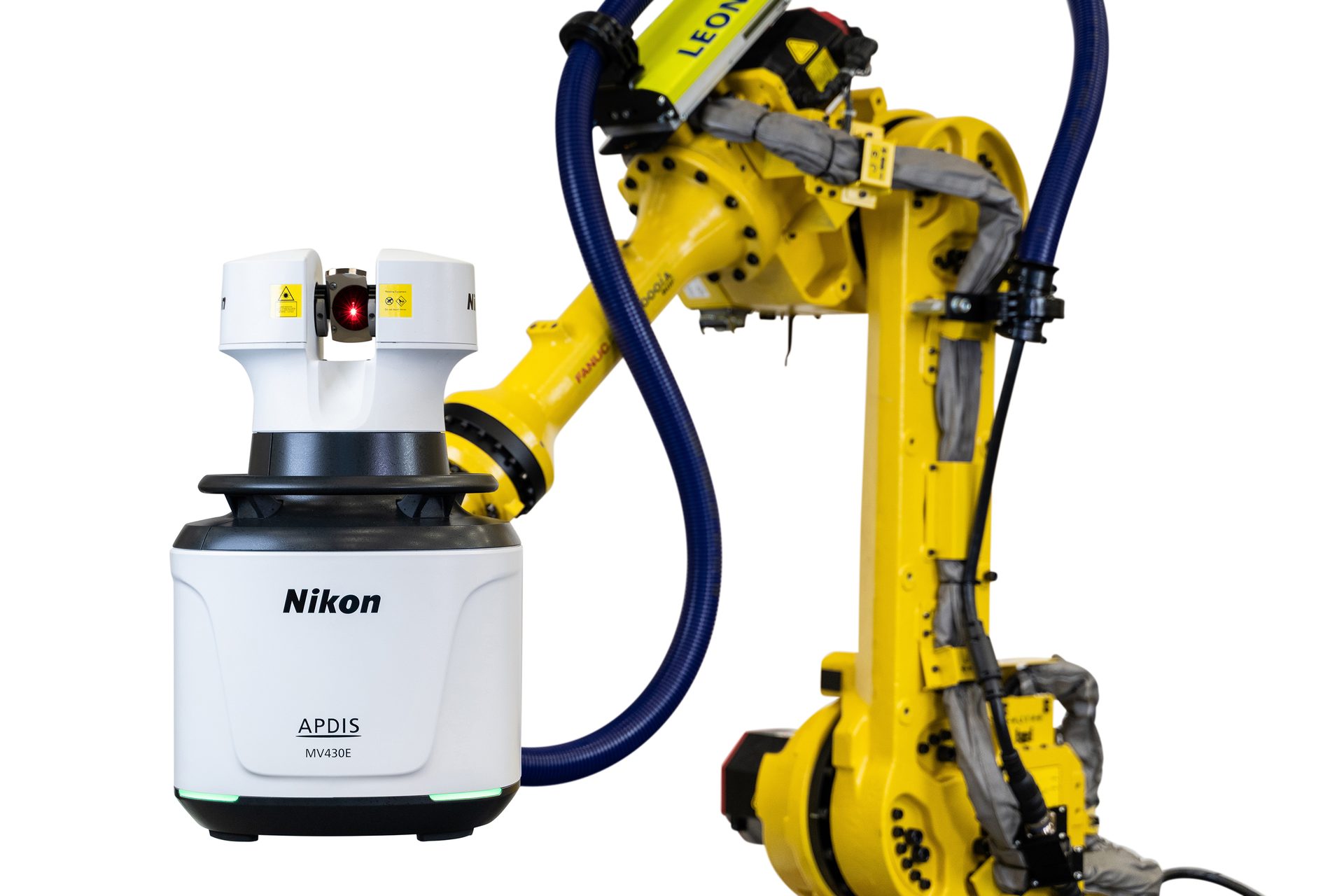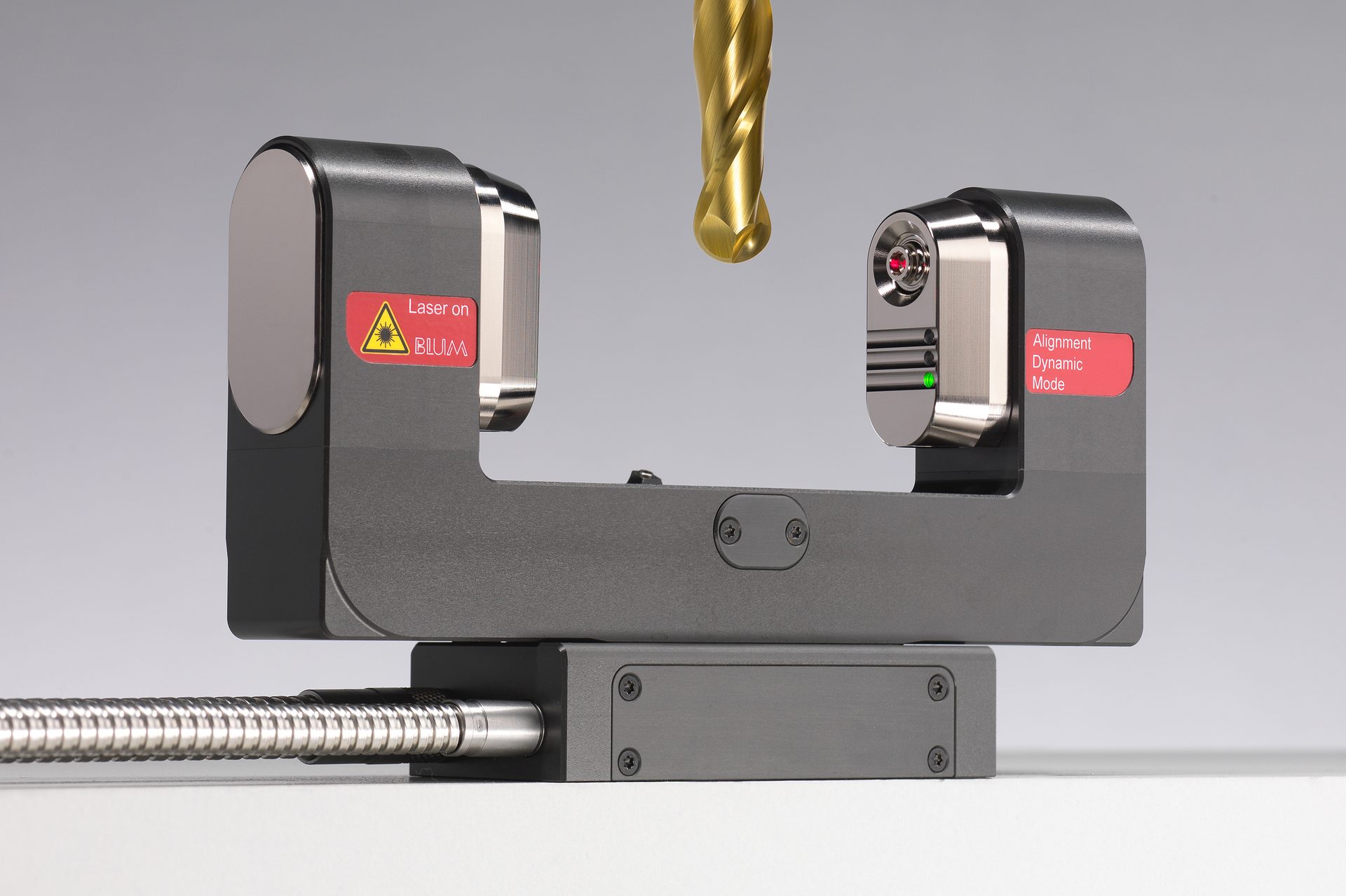Advances in software and hardware make it easier to automate and trust measurement systems. By Genevieve Diesing
Smarter Software and
Non-Contact Tools Drive Adoption of Laser Measurement
measurement
H2 Deck Info By Paragraph Style Bold
Headline
More factories now use laser measurement systems to improve quality control on production lines. These automated systems replace manual inspection methods, measuring parts faster and more accurately.
Laser trackers, laser radars, and other optical measurement devices have gained adoption across several industries. These technologies use laser beams to precisely measure the position, dimensions, and features of manufactured parts. “Automotive, aerospace, defense and medical are currently reaping the most benefits from laser integration,” says Casey Walters, national sales manager at Blum-Novotest. “But, we are seeing growth in any industry that requires precision and repeatability in a high-output environment, especially if they value scrap reduction.”
Automotive Takes the Lead
Automakers are adopting laser measurement systems faster than other industries. Car manufacturing requires checking thousands of parts daily, making automated inspection valuable.
“Automotive is where we see the biggest growth as they move towards absolute inline measurements and next generation offline CMMs, moving away from traditional inspection technologies such as horizontal arm CMMs and robot mounted relative sensors,” says Paul Lightowler, APDIS global product manager at Nikon Metrology.
These systems connect to production lines and measure parts while they’re being made. When measurements show a problem, machines can be adjusted immediately, reducing defects.
Nikon APDIS MV430E Laser Radar ready for automation. Source: Nikon

The LC50-DIGILOG makes use of proprietary Blum-Novotest DIGILOG technology, which combines digital and analog measurement technologies. Source: Blum-Novotest

Aerospace Expansion
Aerospace companies have long used laser measurement tools for large parts. They are now adding automation to these systems to keep up with faster production.
“Aerospace is also a growing area for automation as the production rates increase, so time for measurement is reduced and automation is the only real way to efficiently measure these large structures,” Lightowler says.
Automated systems measure aircraft components more consistently than human inspectors. This helps aerospace companies meet strict safety standards while maintaining production schedules.
Aerospace repair shops now rely on laser measurement for MRO work. With these systems, maintenance crews can inspect complex aircraft parts in hours instead of days. The technology quickly identifies issues in wing assemblies, fuselage components and landing gear that traditional methods often miss. As Rich Nobliski pointed out in Soaring to Success: How Laser Tracker Tech Enhances Maintenance, Repair and Overhaul Operations in the Aerospace Industry, major airlines have slashed repair times dramatically since adopting these systems — some reporting turnaround improvements of up to 40 percent in their busiest maintenance facilities.
Implementation Challenges
Companies adopting automated laser measurement systems face several specific challenges. The most difficult hurdle is often psychological rather than technical.
“The main challenge is a change of approach,” says Lightowler. “Manual measurements have a certain amount of control and trust, and allowing a completely automated measurement to run can, initially, seem like losing control.” Engineers and quality personnel must learn to trust machines to perform inspection tasks they previously handled themselves.
Managing the flood of measurement data presents another challenge. “Laser measuring can bring back thousands of data points per second. This can cause a lot of clutter and paralysis by analysis,” Walters says. “The data that Blum provides is sorted and parsed specific to the user so that the meaningless data is separated from the relevant data to deliver actionable results.”
Initial investment costs can deter some manufacturers. “It can also seem like a large investment in both time and money to implement a fully automated system,” Lightowler says, “but the return on investment can be realized in a relatively short time through improved quality, reducing scrap and waste.”
Nikon APDIS Laser Radar provides non-contact automated measurements. Source: Nikon

APDIS MV430E Laser Radar is used widely across automotive manufacturing. Source: Nikon

Industry Trends
Metrology has changed in recent years. Manufacturers now view measurement as part of production instead of separate quality control. This shift follows manufacturing trends toward automation, connectivity, and data use.
“The mindset of scrap being ‘a part of the process’ is no longer acceptable to advanced manufacturing companies is a noticeable change in our industry,” Walters says. “We see companies actively using lasers and measurement to control and predict production to reduce downtime, errors and out-of-spec parts.”
Competition among measurement system providers drives innovation. Lightowler notes that tracker technology has evolved “from simple SMR measurements to probing and scanners as customers’ needs have changed.” This competition ensures improvements in accuracy, speed and usability.
Automation stands as the dominant trend. “The biggest trend is definitely automation,” Lightowler emphasizes. “This is not just to improve speed but also maintain consistency, allowing for deskilling of repetitive tasks and improving safety.”
This automation push extends beyond measurement tasks to quality management systems that integrate with production processes. “Customers are demanding higher quality but lower prices, meaning that manufacturers are realizing that to improve their product, they need to improve their quality processes,” Lightowler says. “This means more and better data that can only come from automation of the metrology.”
Technology Advancements
Laser measurement tools are getting better at working without touching the object. They’re also faster at processing data and easier to connect with other systems.
Noncontact measurement is basically necessary for automation, experts say. In the past, only a few tools could do this well, but more companies are starting to offer fully noncontact options.
Software has also improved. In addition to collecting and storing data, the brains behind the hardware now helps to automate tasks, communicate with other machines and support real-time decision-making.
As a result of these improvements, integration has also gotten better. That means the measurement system can now connect smoothly with other parts of the manufacturing line. It can send fast, accurate feedback that helps adjust machines on the fly or flag problems before they cause bigger issues. This leads to better quality control, fewer delays, and more efficient production overall.
Scrap Reduction Benefits
Even as technology continues to improve, manufacturers are already seeing concrete benefits in day-to-day operations, as laser measurement systems directly impact factory economics by preventing defective parts. This is a shift from traditional quality control, where problems are often discovered after production runs are complete.
“Measuring tools at their programmed cutting speed provides the most accurate data, ensuring high-quality parts,” Walters says. When cutting tools begin to wear or dimensions drift, operators receive immediate feedback through measurement software, allowing them to make adjustments before producing scrap.
Future Outlook
Looking ahead five to 10 years, laser tracker and radar technology will continue evolving toward fully noncontact operation and deeper integration with production systems.
“For automation, noncontact measurement is a must,” Lightowler says. “There will always be a place for manual measurements, but ease of use and deskilling is a big driver for new developments, so I expect to see more fully noncontact systems being developed to measure faster and more easily.”
Software specifically for laser tracking systems will focus on production integration rather than standalone measurement. “Today’s measurement and automation software is another step on the path to integrating measurement results from machining centers into shop processes, yielding exact measurements, automated tolerances, and warnings to streamline processes and produce more products at a faster rate and a lower cost,” Walters says.
As Industry 4.0 initiatives advance, laser measurement systems will become standard in manufacturing. “The same happened when the manufacturing process itself moved from manual to automated production techniques and now to interconnectivity and the other aspects of Industry 4.0,” Lightowler notes.
This change needs accurate data to evolve, he said, and that’s where metrology automation comes in.
